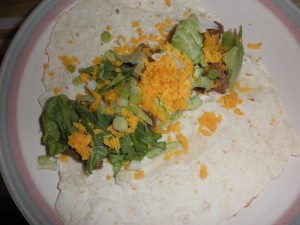 Skip to the recipe!
Skip to the recipe!
Skip to the recipe with pictures!
The hilarious thing about all this is that I never much cared for tortillas when I was a kid. (Or dinner rolls, or French bread–okay, I liked that a little–or pizza; the list goes on!) Bread never felt like it was a big part of my culinary world until it was gone. Tortillas in particular were pasty, dense, and gross, and the fact that they were used to wrap up all sorts of squicky food I didn’t like sure didn’t help their case. It would be great to be able to look back on my early life with the foggy glass of the wisdom of years and say I didn’t care much for so many bready foods because deep down, I knew in my heart they were bad for me, nay, toxic to my very flesh! . . . but no. I was just a picky kid. 😀 Can blame at least part of that on sensory processing disorder, an unrelated malady that makes my family tick somewhat funny, but I just plain didn’t like tortillas. Tortillas were gross, and the things that went in tortillas were even grosser.
Until, one day in my student apartment in college, Sean (yes, the same one Jocelyn married) decided he wanted to make tortillas from scratch, without so much as a recipe to work from. He remembered something vague about baking powder, salt, flour, and water, which he politely pleaded to receive from my pantry, and got to work. I was a year ahead of them in school, which meant I had a kitchen that year and they didn’t, so I tried to make a point of letting them get their cooking urges out when need be–even if I didn’t really understand why cooking was any fun at the time. 🙂 Sean heated up a skillet, and quickly produced the most warm, delicious, tastebud-meltingly good flatbread I’d ever had.
I made a mental note that the trick to good tortillas was apparently to make them yourself, and eat them fresh off the stove, then filed the mental note away and never referred to it again until two years later, a few months after my celiac diagnosis, when my mother and I were nudging a corn tortilla from the store onto a skillet and I was trying to persuade my tongue in advance that no, this would really be quite a nice quesadilla. Making my own tortillas was a real pain until I figured out how to do it; softer dough, gluten substitute instead of xanthan gum, no need to let the dough sit and tick like the wheat-flour recipes I was starting from wanted to, just mix it up and roll it out and cook it.
So, without further ado, the recipe! — without pictures! The recipe with pictures is below!
Yield: 8 plate-size-or-larger tortillas, 10-12 more modestly sized ones
Ingredients:
- 1 3/4 cup dough mix (plus more for rolling)
- 1/4 cup gluten substitute
- 1 1/2 tsp baking powder
- 1 tsp salt
- 2 tsp vegetable oil
- 3/4 cup warm milk
- Possibly a pinch of warm water to make the dough cohere; you don’t want it to get too wet though!
Directions:
- In a stand mixer, mix together the dough mix, gluten substitute, baking powder, and salt; then, add the oil, and mix further.
- Slowly add the warm milk, mixing until the dough forms into a ball. If it won’t quite come together, as sometimes happens, add just 1/4 tsp or less of warm water at a time, then mix again patiently until it does. The problem is that if you let the dough get too moist to roll easily, you can add more dough mix to correct for it, but it’s a real pain and can make the dough just stop behaving altogether. So be cautious when adding liquid, and patient when mixing it together. Use your hands to press the dough together if need be.
- Cut the ball of dough into eight pieces. Cover any dough you aren’t working with at the moment, or it’ll dry out.
- On a flat, generously floured (well, dough-mixed) surface like a countertop or cutting board, roll out one of the pieces of dough into a rough circle. Get the dough as thin as possible without tearing it; the gluten substitute will really help it hold together, so you can get it down to a milimeter thick if things go well. If it falls apart the first time you try to pick it up and move it after rolling it, that’s okay; just roll it up together, redust the rolling surface and rolling pin, then roll it out a second time. Sometimes the dough just wants to pick up a little more dry mix before it’ll behave well, and it usually rolls out much, much better the second time around.
- Heat an ungreased skillet up to high on the stove, then cook the tortilla on one side for about 30 seconds. Make sure the skillet heated all the way so the tortilla will puff nicely.
- Flip the tortilla over, and cook the other side for about 3o seconds. Now it’s done — and ready to eat.
- Make something delicious with it!
And once more, with pictures:
Yield: 8 plate-size-or-larger tortillas, 10-12 more modestly sized ones
Ingredients:
- 1 3/4 cup dough mix (plus more for rolling)
- 1/4 cup gluten substitute
- 1 1/2 tsp baking powder
- 1 tsp salt
- 2 tsp vegetable oil
- 3/4 cup warm milk
- Possibly a pinch of warm water to make the dough cohere; you don’t want it to get too wet though!
Directions:
| 1. In a stand mixer, mix together the dough mix, gluten substitute, baking powder, and salt; then, add the oil, and mix further. | 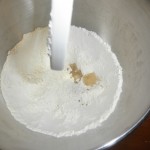 |
| 2. Slowly add the warm milk, mixing until the dough forms into a ball. If it won’t quite come together, as sometimes happens, add just 1/4 tsp or less of warm water at a time, then mix again patiently until it does. The problem is that if you let the dough get too moist to roll easily, you can add more dough mix to correct for it, but it’s a real pain and can make the dough just stop behaving altogether. So be cautious when adding liquid, and patient when mixing it together. Use your hands to press the dough together if need be. | 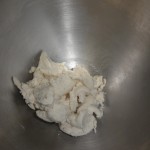 |
| 3. Cut the ball of dough into eight pieces. Cover any dough you aren’t working with at the moment, or it’ll dry out. (I did a half batch, so there’s only four; still, the pieces should be about this size.) | 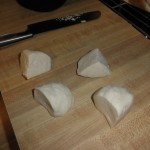 |
| 4. On a flat, generously floured (well, dough-mixed) surface like a countertop or cutting board, roll out one of the pieces of dough into a rough circle. Get the dough as thin as possible without tearing it; the gluten substitute will really help it hold together, so you can get it down to a milimeter thick if things go well. If it falls apart the first time you try to pick it up and move it after rolling it, that’s okay; just roll it up together, redust the rolling surface and rolling pin, then roll it out a second time. Sometimes the dough just wants to pick up a little more dry mix before it’ll behave well, and it usually rolls out much, much better the second time around. | 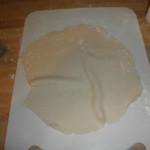 |
| 5. Heat an ungreased skillet up to high on the stove, then cook the tortilla on one side for about 30 seconds. Make sure the skillet heated all the way so the tortilla will puff nicely. | 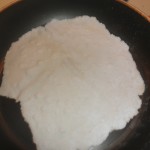 |
| 6. Flip the tortilla over, and cook the other side for about 3o seconds. Now it’s done — and ready to eat. | 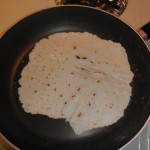 |
| 7. Make something delicious with it! |  |

Leave a Reply